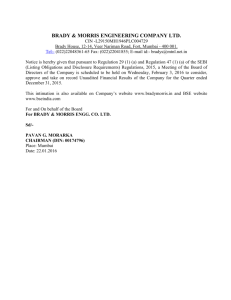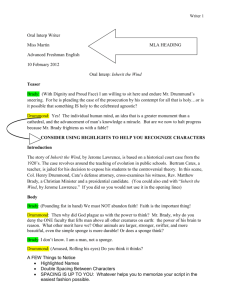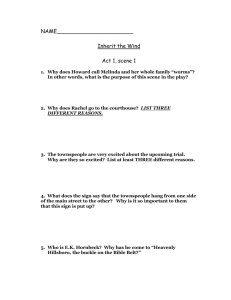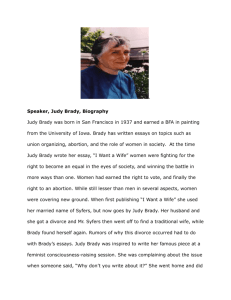Generic concepts in the Clytemnestridae (Copepoda, Harpacticoida), revision and revival RONY BUYS
advertisement
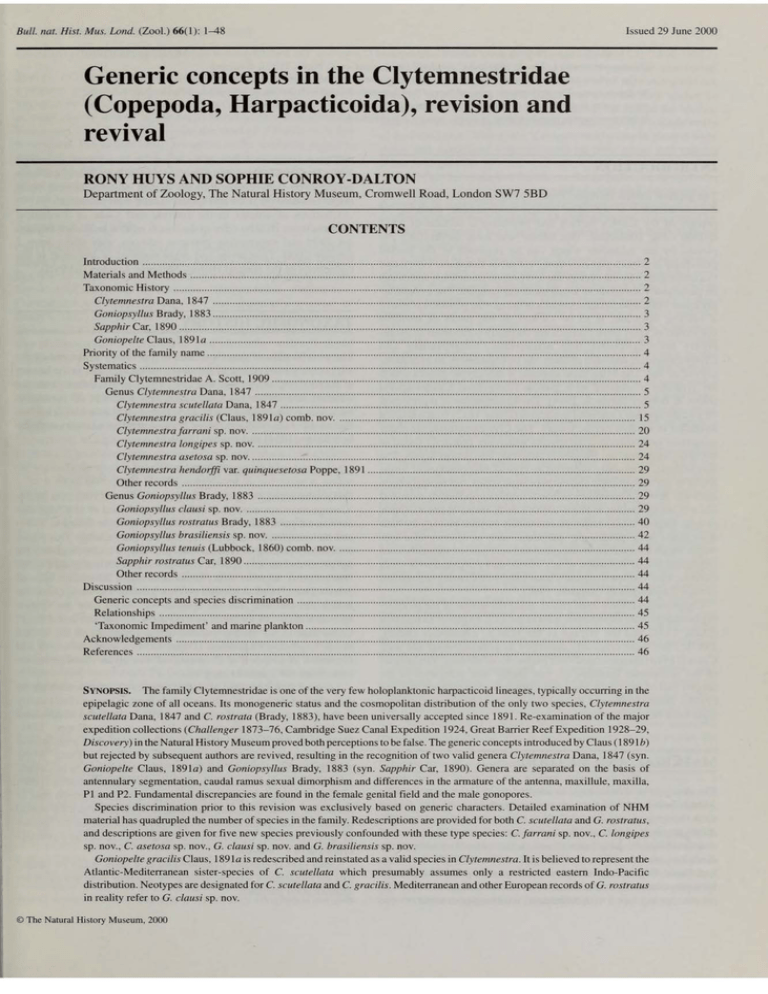
Bull. nar. Hist. Mus. w nd. (Zool.) 66(1): 1-48
Issued 29 June 2000
Generic concepts in the Clytemnestridae
(Copepoda, Harpacticoida), revision and
revival
RONY BUYS AND SOPHIE CONROY-DALTON
Department of Zoology, The Natural History Museum, Cromwell Road, London SW7 5BD
CONTENTS
Introduction ......................... .................................. ........................... ...................................................................... ..................... 2
Materials and Methods ................................. ............................................ ................................................................................... 2
Taxonomic History ...................................................................................................................................................................... 2
CJytert1nestra Dana, 1847 ........................................................................................................................................................ 2
Goniopsyllus Brady, 1883 ........................................................................................................................................................ 3
Sapphir Car, J 890 ... ......... ........................................................................................................................................................ 3
Go1iiopelte Claus, l89 I a. ................. ................................................................................................................... ..................... 3
Priority of the family na.tne ................. .......... ............................................................................................................................... 4
Systematics .................................................................................................................................................................................. 4
-Family CJytemnestridae A. Scott, l909 ................................................................................................................................... 4
Genus Clyten1nestra Dana, 1847 ......................................................................................................................................... 5
Clytem11est·ra scu1ella1a Dana, 1847 ................................................................................................................................ 5
Clytemnestra gracilis (Claus, J89 la) comb. nov................................ .......................................................................... 15
Clytemriesrrafarratzi sp. nov. ............................ ............................................................. ............................................... 20
Clytemnes1-ra long;pes sp. nov . ....... ............................................................................................................................... 24
Clytemnestra asetosa sp. nov..................................................................................................................................... .... 24
Clyremnestra hendorffi var. quinqueserosa Poppe. 1891 ............................................................................................... 29
Other records ..................................................................................................................................................... ............ 29
Genus Goniopsyllus Brady, 1883 ................................... ...... .................................... ......... .. ......................... ................ ..... 29
Goniopsylli's clausi sp. nov. .......................................................................................................................................... 29
Goniopsyllus rostrarus Brady, 1883 ........................ .................... .................................................................................. 40
GoniopS)1/Jus br<t~·i/iensis sp. nov. ................................................................................................................................. 42
Goniopsyllus tenuis (Lubbock, 1860) comb. nov.......................................................................................................... 44
Sapphir rostratus Car, 1890 ............................. .............................................................................. ......... ................. ...... 44
Other records ................. ................. ............................................................................................... ......................... ....... 44
Discussion ········································································-··························-·-····································································· ······ 44
Generic concepts and species discrim.i nation ............................................................... ......................................................... 44
Relationships ........ ......... ........................................................................................................................................................ 45
'Taxonomic Impediment' and marine plankton ..................................................................................................................... 45
Acknowledgements .......... ................... ........................ ........................................... ................................. ......... ......................... 46
References .................................. ......... ........................................................... ........................................................................... 46
The family Clytemnestridae is one of the very few holoplanktonic harpacticoid lineages, typically occurring in the
epipelagic zone of all oceans. Its monogeneric status and the cosmopolitan distribution of the only two species, Clytemnesrra
scutellata Dana, 1847 and C. rostrata (Brady, 1883), have been universally accepted since 1891. Re-examination of the major
expedition collections (Challenger 1873-76, Cambridge Suez Canal Expedition 1924, Great Barrier Reef Expedition 1928-29,
Discovery) in the Natural History Museum proved both perceptions to be false. The generic concepts introduced by Claus ( 189 lb)
but rejected by subsequent authors are revived, resulting in the recognition of two valid genera Clyternnestra Dana, 1847 (syn.
Goniopelte Claus, 1891a) and Goniopsyllus Brady, 1883 (syn. Sapphir Car, 1890). Genera are separated on the basis of
antennulary segmentation, caudal ramus sexual dimorphism and differences in the armature of the antenna, maxillule, maxilla,
Pl and P2. Fundamental discrepancies are found in the female genital field and the male gonopores.
Species discrimination prior to this revision was exclusively based on generic characters. Detailed examination of NHM
material has quadrupled the number of species in t!ie family. Redescriptions are provided for both C. scutellata and G. rostratus,
and descriptions are given for five new species previously confounded with these type species: C. farrani sp. nov., C. longipes
sp. nov., C. asetosa sp. nov., G. clausi sp. nov. and G. brasiliensis sp. nov.
Goniopelte gracilis Claus, 189 la is redescribed and reinstated as a valid species in Clytemnesrra. It is believed to represent the
Atlantic-Mediterranean sister-species of C. scutellata which presumably assumes only a restricted eastern Indo-Pacific
distribution. Neotypes are designated for C. scutellata and C. gracilis. Mediterranean and other European records of G. rostratus
in reality refer to G. clausi sp. nov.
SYNOPSIS.
© The Natural History Museum, 2000
2
R. HUYS AND S. CONROY-DALTON
C. hendoiffi Poppe, 1890 is a junior subjective synonym of C. scutellata. The doubtful status of Sapphir rostratus Car, 1890,
Clyterrznestra tenuis Lubbock, 1860 and C. hendoiffi. var. quinquesetosa Poppe, 1890 is discussed.
The intricate taxonomic history of the family is reviewed, including the nomenclatural confusion surrounding the priority of
the family name. The phylogenetic relationships of the Clytemnestridae as well the ontogenetic processes underlying the caudal
ramus sexual dimorphism in Clytemnestra are discussed. The taxonomic impediment in marine plankton research caused by the
failure to recognize pseudo-sibling or cryptic species is highlighted.
INTRODUCTION
The greatest habitat shift performed by copepods was undoubtedly
the colonization of the open pelagic environment, covering 71
percent of the Earth's surlace and providing a volume of 1347
million cubic kilometres. This habitat was most successfully exploited by the calanoids which can be regarded as the marine
planktonic copepods par excellence (Huys & Boxshall, 1991), and
to a lesser extent by the cyclopoids and poecilostomatoids which can
be particularly abundant in small mesh net samples. The evolutionary history of harpacticoid copepods in the marine plankton is less of
a success story and is to be viewed as the result of multiple
colonization. Only three families are currently considered as exclusively holoplanktonic, the Miraciidae, Euterpinidae and
Clytemnestridae, and each of them can be regarded as an evolutionary cul de sac. The Miraciidae contains 4 monotypic genera which
are typically associated with inarine filamentous Cyanobacteria
(Huys & Bottger-Schnack, 1994). The Euterpinidae is represented
by a single species Euterpina acutifrons (Dana, 1847) which is often
abundant in shallow neritic waters. The Clytemnestridae currently
comprises two cos1nopolitan species which are primarily found in
the epipelagic zone but frequently penetrate into deeper layers. The
Aegisthidae, commonly regarded as typical boloplanktonic forms
found in the mesopelagic and bathypelagic zones, has recently been
shown to be only a secondary offshoot from a hyperbenthic ancestral
stock (Conroy-Dalton & Huys, 1999; Lee & Huys, in press). Other
pelagic harpacticoids exhibit an essentially benthic biology by their
association with 'planktonic' substrata, such as Microsetella spp.
which attach themselves to discarded and occupied larvacean houses
(Appendicularia) (Ohtsuka et al., 1993), and Parathalestris croni
(KrS('Syer, 1846) which is typically associated with floating macroalgal
clumps (Ing6lfsson & Olafsson, 1997).
Clytemnestrids have been known since the advent of the pioneering oceanographic expeditions such as the U.S. Explorer Expedition
(Dana, 1854) and the Voyage of the H.M.S. Challenger (Brady,
1883). They were originally classified as poecilostomatoids until
Claus (189 Ja) demonstrated their harpacticoid identity. Virtually all
of the taxonomic literature on this family was published in the
second half of the 1800s and apart from cursory treatment by Lang
(1948), Wells (1970) and Boxshall (1979) no significant contributions have been added since.
MATERIAL AND METHODS
The descriptive terminology is adopted from Huys et al. (1996).
Abbreviations used in the text are: ae, aesthetasc; Pl-P6, first to
sixth thoracopod; exp(enp )-1 (2, 3) to denote the proximal (middle,
distal) segment of a ramus. Specimens were dissected in lactic acid
and the dissected parts were placed in lactophen9l mounting medium. Preparations were sealed with glyceel (Gurr®, BDH Chemicals
Ltd, Poole, England) or transparent nail varnish. All drawings have
been prepared using a camera lucid a on a Leitz Dialux or Leitz DMR
microscope equipped with differential interference contrast.
Clytemnestra gracilis and Goniopsyllus clausi were examined
with a Philips XL30 scanning electron microscope. Specimens were
prepared by dehydration through graded acetone, critical point
dried, mounted on stubs and sputter-coated with palladium.
Citations of articles in the International Code of Zoological
Nomenclature (ICZN) refer to the fourth edition published in August 1999 and superseding previous editions with effect from 1
January 2000. Type series and other material is deposited in the
collections of the Natural History Museum, London (BMNH).
TAXONOMIC IDSTORY
The proliferation of generic names in this family at the end of the
19th century marked one of the most virulent episodes in the history
of harpacticoid taxonomy. The key players in this debate were the
eminent and influential Carl Claus and a cohort of opponents
including Wilhelm Giesbrecht, S.A. Poppe and Lazar Car. It is clear
that much of the confusion arose from observational errors made by
both Dana ( 1854) and Brady (1883).
Clytemnestra Dana, 1847
Dana introduced the genus Clytemnestra in the first part of his
'Conspectus Crustaceoru1n' which was published in 1847 (for discussion of publication dates see Huys & Bottger-Schnack, 1994)
and included the families Cyclopidae and Harpactidae. This paper,
completely lacking in illustrations, provided a Latin diagnosis for
the genus and its only species C. scutellata which was placed in the
' Harpactidae' together with Harpacticus Milne Edwards, 1840 and
Setella Dana, 1846. Although no type locality was designated, the
author did mention that the species was found near the Gilbert
Islands and east of Tuamotu in the Pacific Ocean and in the South
China Sea. In his second volume of the Crustacea of the United
States Exploring Expedition (Dana, 1854) a more extensive and
illustrated description of C. scutellata was given based on specimens from the Tuamotu samples.
Lubbock (1856) added a second species C. atlantica which he
described on the basis of a single female from an unspecified locality
in the Atlantic. The brief original description included illustrations
of the habitus and antenna only. Various authors (Poppe, 1891;
Giesbrecht, 1892; Lang, 1948) have questioned this identification
and referred the species to the genus Pach.as Stebbing in the
Poecilostomatoida. Pesta (1909) considered C. atlantica as a synonym of Pachos punctatum (Claus). In a later report Lubbock (1860)
described C. tenuis, again from a single female, collected east of
Mauritius. Lubbock himself bad some reservations about the sexual
maturity of the specimen, and Poppe (1891) considered the species
as unrecognizable. Giesbrecht (1892) listed C. tenuis as a possible
synonym of C. rostrata.
Claus (1863) rejected Clytemnestra as a valid genus by stating
that the illustrations were so inadequate that they were worthless for
identification purposes.
3
GENERIC CONCEPTS IN CLYTEMNESTRIDAE
Goniopsyllus Brady, 1883
Brady (1883) established this genus for a single specimen found in
a tow-net gathering taken off the Argentinean coast during the
voyage of the H.M.S. Challenger. He regarded Goniopsyllus rostratus
as most closely related to the harpacticoid genera Enhydroso1na
Boeck and Cletodes Brady despite the marked differences in the
moutbparts. In addition, Brady remarked on the similarity in swimming leg morphology with Peltidium and recognized a certain
affinity with the Sapphirinidae because of the rudimentary structure
of the mouthparts. The description of G. rostratus is fragmentary
and partly inadequate. Brady (1883) failed to observe the mandible.
Sapphir Car, 1890
Car (1890) described both sexes of Sapphir rostra/us from plankton
samples taken off Trieste in the Adriatic. He used and revised
Brady's ( 1878) classification, dividing the free-living copepods in 6
families (Calanidae, Cyclopidae, H arpactidae, Peltididae,
Corycaeidae and Sapphirinidae), but was apparently unaware of
Brady's ( 1883) later paper describing the closely related Goniopsyllus
rostratus. Car ( 1890) placed Sapp hir in the Sapphirinidae merely by
way of elimination and excluded the genus from the two harpacticoid
families known at that time (Harpactidae, Pel tididae) by virtue of the
absence of (1) geniculate setae on the antennae, (2) a palp on the
mandible and maxillule, (3) modifications of the P 1, and (4) a
foliaceous PS. Allocation to the Sapphirinidae was substantiated by
the dorsoventrally depressed body, the 6-segmented antennules
which are similar in both sexes (Car did not recognize the sexual
dimorphism and male geniculation), the antenna Jacking a defined
exopod and geniculate setae on the endopod, the reduced moulhparts,
the sexually dimorphic maxillipeds and the small PS.
In a short note Dahl ( 1890) considered S. rosrratus a junior
subjective synonym of G. rostratus but gave no justification for this
course of action.
Car (1891a) admitted that he had overlooked Brady's ( 1883)
Challenger report describing G. rosrratus but maintained the distinction between both genera. His conviction was based on three
doubtful observations rnade by Brady ( 1883): (I) his statement that
all four swimming legs were 'nearly alike' having 3-segmented
rami; Brady only figured the P2 which he labelled 'One of the
swimming feet' , (2) the maxillipeds which were described and
figured as 3-segmented, and (3) the 3 -segmented fifth legs. Car
pointed out that in Sapphir the Pl exopod was clearly 1-segmented,
and both the maxillipeds and the PS 2-segmented, but did not
consider the possibility that this incongruity could be based on
observational errors made by Brady. It was largely this failure that
initiated the subsequent dispute between Car and Claus.
Goniopelte Claus, 1891a
Both sexes of Goniopelte gracilis were described in remarkable
detail by Claus (189la) on the basis of scanty material (12 and lo)
collected from an unspecified locality in the Eastern Mediterranean.
He recognized the male geniculation ( 'elastischen Cuticularapparat')
and the 'accessory' aesthetascs of the antennules, the sexual dimorphism of the caudal rami and the presence of the male P6. Claus also
r evealed details of the internal anatomy such as the tripartite nauplius
eye, the asymmetry of the male genital system and the presence of
integumental glands around the rostrum and the pleural areas of the
cephalothorax, pedigerous somites and abdomen.
Claus (1891 a) severely criticized the quality of both Brady's
(1883) and Car's (1890) descriptions and like Dahl (1890) professed
that G. rostratus and S. rostratus were not only congeneric but also
conspecific. The differentiating characters used by Car ( 1890, 189 la)
he regarded as irrelevant to the issue. He presented convincing
arguments showing that Brady's holotype of G. rostratus could not
possibly have been a male. Claus was also the first author to
reconsider Dana's Cly1emnestra scutellata. He placed the species
with reservations in the Scutellidiinae (' Scutellidinen' ), a subfamily
of the Peltidiidae ( 'Peltididen' ), despite similarities in general body
shape and maxilliped structure with his new genus and species
Goniopelte g racilis.
Claus (1891a) remarked that the moderate flattening of the body,
the reduction of the mandible and maxillule, and the 1-segmented Pl
exopod in G. gracilis would probably warrant the erection of a third
subfamily within the Peltidiidae. An alternative option suggested by
Claus was to regard it as a transitionary group between the Peltidiidae
and Harpacticidae.
Car's ( 189 lb) re-examination of S. rostratus did not disclose new
information apart from the conf1rmation of the 4-segmented condition of the antenna. Although his rebuttal was mainly ai1ned at
showing disapproval of Claus' (1891a) provocative paper, it contained clear indications of the author's ambivalence about both the
conspecificity and familial place1nent of S. rostratus. Car maintained the laner as a valid genus and species but did not exclude
potential synonymy with G. rostratus. He kept the genus in the
Sapphirinidae but pointed out the close relationship between Sapphir,
Goniopsyllus and Goniopelte and the possible option of proposing a
new famiJy for these three genera. Finally, he disagreed with Claus
( 189 la) on the sexual identity of the holotype of G. rostratus, using
the unconfirmed presence of an internal spennatophore in Brady's
( 1883) habitus drawings as the only counterargument.
A breakthrough in unravelling the intricate synonymy was realized
by Poppe who had already recognized the identity between
Clyte111nestra and Goniopsyllus in 1884 but did not publish his results
until 1891. Poppe's (1891) comprehensive paper, which downgraded
Goniopsyllus and Sapphir to junior synonyms of Clyte1nnestra, was
based on a wide range of specimens including the holotype of G. rostratus and a male of S. rostratus fro1n Car's collection. He described
a ne•v species, Clyte1111zestra hendorffi from material coHected in the
Java Sea, the Indian Ocean (south of Madagascar, Western Australian
Basin) and the South Atlantic (off Brazil and Argentina). Poppe
(189 L) also re-examined Thompson's ( 1888) material of G. rostratus
from Malta and identified it as C. hendorffi. Among the material from
the Java Sea he discovered a variety quinquesetosa which differed
from the typical form in the longer PS which carried only S setae on
the exopod, a more stocky abdomen in both sexes and the caudal rami
which were relatively wider proxi1nally.
Poppe (1891) syoonymised G. rostratus and S. rostratus and
considered the previous distinction between them to be based on
erroneous observations of the PS by both Brady and Car, and the fact
that Brady had nlisidentified the holotype of S. rostratus as a male
and overlooked the Pl exopod in this species. For some unknown
reason he suspected the latter to be 2-segmented in G. rostratus. He
considered only 3 species as valid, all of which he placed in
Clyte1nnestra: C. scutellata, C. hendorffi and C. rostrata (Brady).
Poppe further regarded the inadequately described C. tenuis as a
probable synonym of C. scutellata and excluded Lubbock's second
species C. at/antica from the genus on account of the different body
shape and the structure of the antennules.
Poppe (1891) did not accept Car's (1890, 1891a-b) placement in
theSapphirinidaeand created a new family Pseudo-Peltididae which
showed similarities with the Peltidiidae but differed in the morphology of the Pl (exopod not prehensile and 2-segmented (!)according
to Poppe's diagnosis), the absence of a well defined antennary
exopod and strongly reduced mouthparts.
